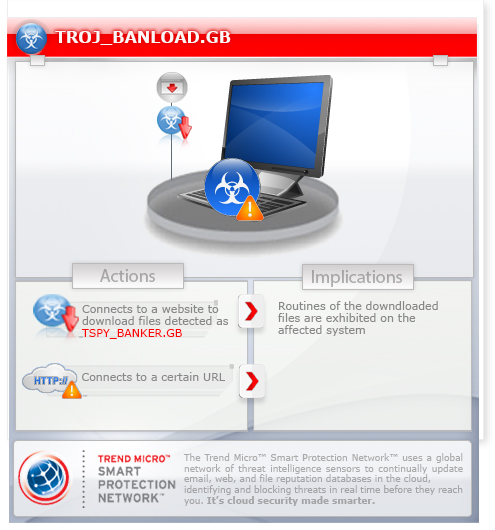TROJ_BANLOAD.GB
Trojan horse Delf.ANOM (AVG) ,Trojan-Dropper.Delf (Ikarus) ,Win32/Spy.Banker.AALD trojan (Eset)
Windows 2000, Windows Server 2003, Windows XP (32-bit, 64-bit), Windows Vista (32-bit, 64-bit), Windows 7 (32-bit, 64-bit)


Threat Type: Trojan
Destructiveness: No
Encrypted:
In the wild: Yes
OVERVIEW
Downloaded from the Internet, Dropped by other malware
This BANLOAD variant checks for the presence of G-buster Plugin, a plugin that prevents malicious code from running during a banking session, on the system. It does this to indicate if the system is being used for online banking. However, this malware is able to execute its payload despite the presence of the said plugin.
To get a one-glance comprehensive view of the behavior of this Trojan, refer to the Threat Diagram shown below.

This Trojan arrives on a system as a file dropped by other malware or as a file downloaded unknowingly by users when visiting malicious sites. It may be downloaded by other malware/grayware/spyware from remote sites.
TECHNICAL DETAILS
1,005,056 bytes
EXE
No
23 Jan 2014
Downloads files, Connects to URLs/IPs
Arrival Details
This Trojan arrives on a system as a file dropped by other malware or as a file downloaded unknowingly by users when visiting malicious sites.
It may be downloaded by other malware/grayware/spyware from remote sites.
Installation
This Trojan drops the following non-malicious file:
- %Application Data%\tcefni.dat
(Note: %Application Data% is the current user's Application Data folder, which is usually C:\Documents and Settings\{user name}\Application Data on Windows 2000, XP, and Server 2003, or C:\Users\{user name}\AppData\Roaming on Windows Vista and 7.)
Download Routine
This Trojan connects to the following website(s) to download and execute a malicious file:
- http://{BLOCKED}venturoso.com.br/modulo.txt
It connects to the following URL(s) to download its configuration file:
- http://{BLOCKED}venturoso.com.br/htp.txt
It saves the files it downloads using the following names:
- %Application Data%\tpp.dat - config
- %Application Data%\{random}.txt - detected as TSPY_BANKER.GB
(Note: %Application Data% is the current user's Application Data folder, which is usually C:\Documents and Settings\{user name}\Application Data on Windows 2000, XP, and Server 2003, or C:\Users\{user name}\AppData\Roaming on Windows Vista and 7.)
NOTES:
It connects to the following URL to log infection to malware server:
- http://{BLOCKED}venturoso.com.br/log.php?tipo={type of log}&name={filename of downloaded}&dados={data collected}
SOLUTION
9.700
10.528.02
08 Jan 2014
10.529.00
08 Jan 2014
Step 1
Before doing any scans, Windows XP, Windows Vista, and Windows 7 users must disable System Restore to allow full scanning of their computers.
Step 3
Search and delete these files
- %Application Data%\tcefni.dat
- %Application Data%\tpp.dat
Step 4
Scan your computer with your Trend Micro product to delete files detected as TROJ_BANLOAD.GB. If the detected files have already been cleaned, deleted, or quarantined by your Trend Micro product, no further step is required. You may opt to simply delete the quarantined files. Please check this Knowledge Base page for more information.
Did this description help? Tell us how we did.

